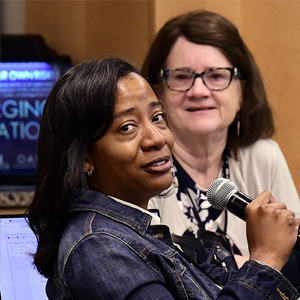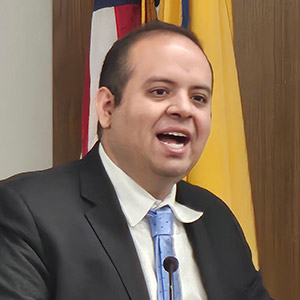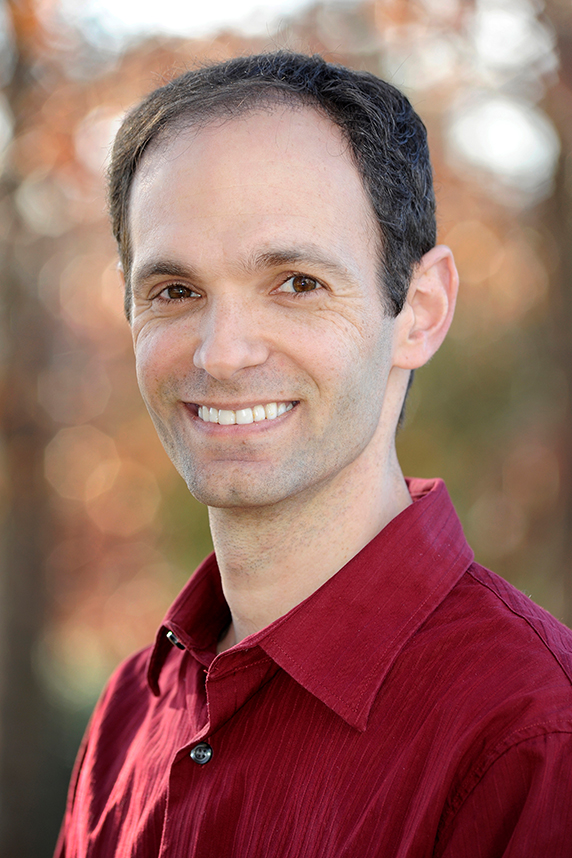 Hollander’s research background includes the use of genetic, behavioral, electrophysiological, and pharmacological methods to study drug addiction and obesity. (Photo courtesy of Steve McCaw / NIEHS)
Hollander’s research background includes the use of genetic, behavioral, electrophysiological, and pharmacological methods to study drug addiction and obesity. (Photo courtesy of Steve McCaw / NIEHS)During a workshop titled “Modernizing Neurotoxicology at NIEHS: Technologies to Applications in Environmental Health Sciences,” experts shared state-of-the-art research tools that they say will boost understanding of how pollutants affect the brain and influence disease. Held April 19-20, the event featured 17 presentations on subjects ranging from advances in neuroimaging to in vitro (cell-based) approaches in developmental neurotoxicology.
“As the primary federal agency supporting medical and behavioral research for the nation, it is critical that NIH [the National Institutes of Health] stays in tune with recent scientific advances,” said event organizer Jonathan Hollander, Ph.D., program director in the Genes, Environment, and Health Branch at NIEHS. “It is important to examine the applicability of modern-day neuroscience approaches to toxicological research.”
Emerging technology, enhanced capabilities
Goals of the workshop were to review neurological research advances, including new tools and lessons learned; identify key questions in environmental health that would benefit from the use of these methods; and develop a strategy to encourage adoption of emerging technologies. The conference included the following four sessions.
- “Advances in Neuroimaging,” chaired by Robert Sills, D.V.M., Ph.D., from the NIEHS Division of the National Toxicology Program (DNTP), and Kimberly Gray, Ph.D., from the institute’s Population Health Branch.
- “In Vitro Approaches in Developmental Neurotoxicology Research,” chaired by Christopher McPherson, Ph.D., from DNTP, and Shannah Witchey, Ph.D., a former DNTP trainee who now works at the pharmaceutical company Inotiv.
- “Chemogenetic, Optogenetic, and Fiber Photometry for Advancing Neurotoxicology,” chaired by Hollander and Jesse Cushman, Ph.D., from the NIEHS Neurobehavioral Core Laboratory.
- “Emerging Spatial Technologies,” chaired by Jian-Liang Li, Ph.D., from the NIEHS Integrative Bioinformatics Support Group, and Benedict Anchang, Ph.D., from the institute’s Biostatistics and Computational Biology Branch.
 Sills, left, and Gray, right, moderated a 45-minute panel discussion at the end of the session they chaired, spurring lively conversation among presenters. (Photos courtesy of Steve McCaw / NIEHS)
Sills, left, and Gray, right, moderated a 45-minute panel discussion at the end of the session they chaired, spurring lively conversation among presenters. (Photos courtesy of Steve McCaw / NIEHS)Addressing public health challenges
“Adopting the technology discussed in this workshop will require greater collaboration among neuroscientists and environmental health scientists,” noted Rick Woychik, Ph.D., director of NIEHS and the National Toxicology Program. “There is a critical need to use cutting-edge research methods to advance our understanding of the neurotoxicological effects of environmental exposures,” he added.
“NIEHS has a strong interest in neuroscience and neurotoxicology in particular,” said DNTP Scientific Director Brian Berridge, D.V.M., Ph.D. “The evidence is growing that environmental exposures are probably significantly contributing to not only developmental neurological diseases but also chronic progressive diseases,” he told attendees. Berridge added that the environmental health sciences community should aim to increase uptake of new research technology and capabilities that will address that public health challenge.
Shedding light on autism
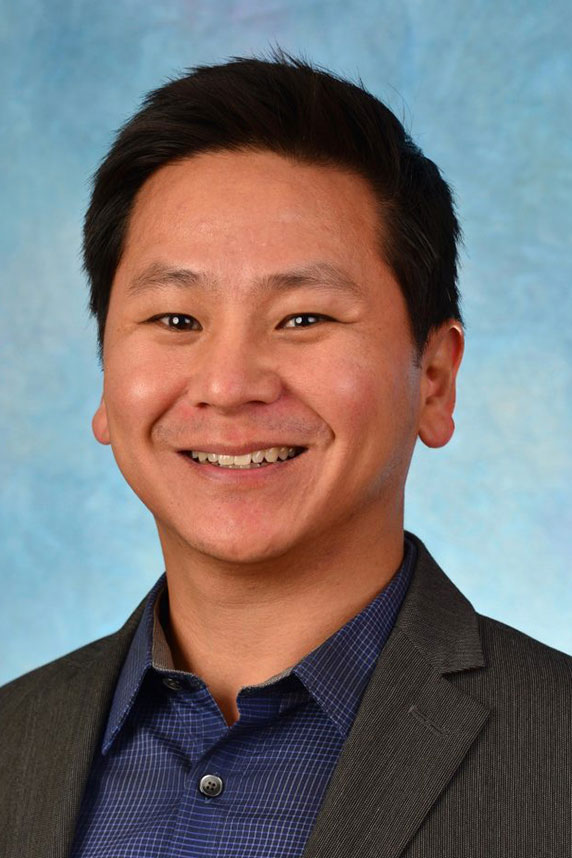 Shen is an assistant professor at the UNC School of Medicine, and he holds appoints in the department of psychiatry, the UNC Neuroscience Center, and the Carolina Institute for Developmental Disabilities. (Photo courtesy of Mark Shen)
Shen is an assistant professor at the UNC School of Medicine, and he holds appoints in the department of psychiatry, the UNC Neuroscience Center, and the Carolina Institute for Developmental Disabilities. (Photo courtesy of Mark Shen)A method to identify early risk markers of autism called longitudinal neuroimaging spurred significant interest and discussion at the conference. In his lab at the University of North Carolina at Chapel Hill (UNC), Mark Shen, Ph.D., uses magnetic resonance imaging (MRI) in both infants and mouse models to identify biological origins of neurodevelopmental disorders and to test potential therapeutics.
Through funding from NIH, Dr. Shen’s team is following 500 infants who are part of the Infant Brain Imaging Study. Using MRI scans taken at 6, 12, and 24 months, as well as other phenotypic data, he and his collaborators aim to determine what factors indicate whether a baby will receive an autism diagnosis.
“Brain changes that are detectable with MRI in the first year of life actually precede the onset of behavioral symptoms and can predict later autism outcomes,” said Shen.
Recent research shows that accelerated brain growth between 6 and 12 months of age is an autism indicator, according to Shen. Another indicator during that time is accelerated growth of the amygdala, an area of the brain involved in interpreting emotional meaning from our surroundings. Other autism markers include altered connections between brain regions, and excessive cerebrospinal fluid (CSF) surrounding the brain, noted Shen.
He added that during the next five years, his team will conduct NIH-funded clinical and pre-clinical studies to better understand CSF physiology and brain development of autism and related conditions.
Fluorescent sensors bolster Parkinson’s research
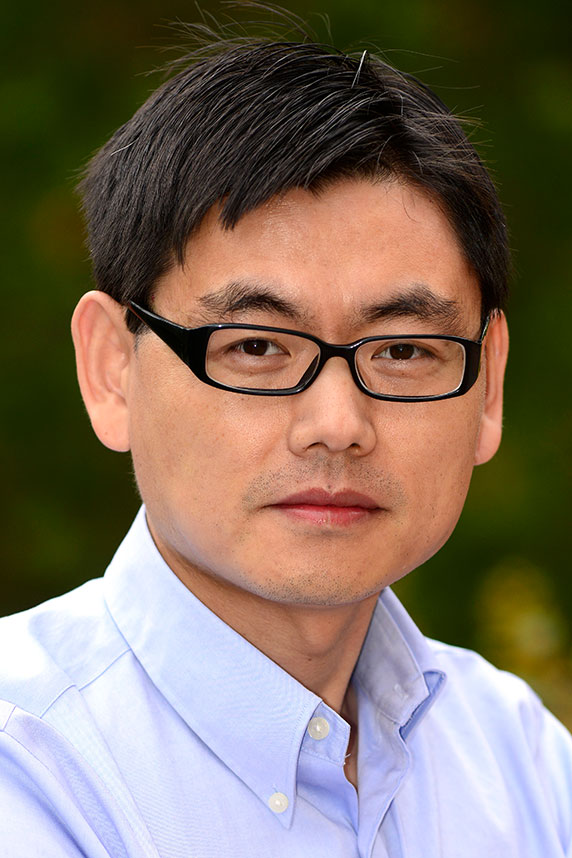 Last November, Cui hosted an NIEHS Distinguished Lecture on links between mitochondrial damage and Parkinson’s disease. (Photo courtesy of Steve McCaw / NIEHS)
Last November, Cui hosted an NIEHS Distinguished Lecture on links between mitochondrial damage and Parkinson’s disease. (Photo courtesy of Steve McCaw / NIEHS)One of the fundamental questions in neuroscience research is how our brains control behavior, something studied by Guohong Cui, M.D., Ph.D., who leads the NIEHS In Vivo Neurobiology Group.
However, many of the existing techniques to evaluate behavior are limited, according to Cui. So, he is using multicolor fiber photometry, a method that can measure brain activity in rodent models.
Using genetically encoded fluorescent sensors, such as voltage, calcium, and neurotransmitter sensors, researchers can observe different groups of neurons when mice engage in certain behaviors.
Cui is studying Parkinson’s disease and the death of dopamine neurons, some of which are particularly vulnerable due to their existing calcium levels.
Learn more about Cui’s research.
Increasing collaboration, adopting new tools
“I think it is important that we establish more collaboration to remove barriers between environmental health scientists and neuroscientists,” said Gray. “I believe there are exciting opportunities for us to use the imaging tools and other technologies discussed at this conference to bridge those gaps,” she added.
“I think those of us who are neuroscientists here at NIH have the perception that perhaps the field could be quicker at adopting and assimilating some of these modern tools,” said Cindy Lawler, Ph.D., the chief of the Genes, Environment, and Health Branch of NIEHS. “When you bring people together and give them opportunities to share, magic happens.”
(Susan Cosier is a contract writer for the NIEHS Office of Communications and Public Liaison.)





